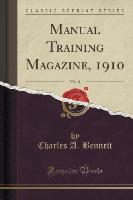- Start
- Manual Training Magazine, 1910, Vol. 11 (Classic Reprint)
Manual Training Magazine, 1910, Vol. 11 (Classic Reprint)
Angebote / Angebote:
Excerpt from Manual Training Magazine, 1910, Vol. 11During the next eleven days and the last five days before sailing for home I spent my time in London and places within easy reach by train. My chief aim during this time was to become acquainted with the manual training work in both the elementary and higher elementary schools, and as a secondary aim, to get acquainted with the work Of a few typical industrial schools and schools Of arts and crafts. Of course I spent some time in the museums, at St Paul's Cathedral and West minster Abbey, but I did not attempt to see the sights of London in the conventional way. It was more in harmony with my purpose to visit schools in Operation and talk with the men who are influencing English education and the teachers who are meeting the every-day problems of the shop and classroom.I shall never forget a morning call on Alfred Mosely. He was very busy, but not too busy to welcome another American teacher. I shall always remember his cordial greeting and his questions concerning Bradley Polytechnic Institute and its work. My brief interview with him was another proof of his deep interest in American schools, and recalled the origin of the Mosely commissions as told by Mr. Mosely himself. In his preface to the report Of the 1903 commission he says' The story of the origin of the Industrial and Educational Commissions to the United States takes me back to South Africa some fifteen years ago. I had for many years been engaged in mining Operations at Kimberley, which, in common with the work Of the great bulk of the diamond diggers, had proved unremunerative, when Gardner Williams, the California engineer, arrived in South Africa, and took over the management of the De Beers Company, which the late Cecil Rhodes was just then amalgamating. Gardner Williams in turn imported the late Louis Seymour. TO the latter, by the way, the British nation owes a debt of gratitude for his engineering work in Natal in the early stages of the recent Boer war. By repairing bridges as fast as they were destroyed by the enemy, and so keeping open the lines Of communication without which Operations in Natal would have been impossible, he and his volunteer company did yeoman service, and ultimately he lost his life whilst leading some of his men to cover in the defence of a bridge at Zand River. Gardner Williams and Louis Seymour were followed by many other American engineers, in cluding Perkins, Jennings, and Hammond, the last two, it is interesting to note.About the PublisherForgotten Books publishes hundreds of thousands of rare and classic books. Find more at www.forgottenbooks.comThis book is a reproduction of an important historical work. Forgotten Books uses state-of-the-art technology to digitally reconstruct the work, preserving the original format whilst repairing imperfections present in the aged copy. In rare cases, an imperfection in the original, such as a blemish or missing page, may be replicated in our edition. We do, however, repair the vast majority of imperfections successfully, any imperfections that remain are intentionally left to preserve the state of such historical works.
Folgt in ca. 5 Arbeitstagen




